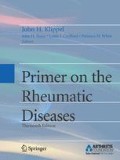Abstract
-
The pathophysiology of osteoporosis includes many genetic, hormonal, nutritional, and environmental influences. Some risk factors for this condition are well defined.
-
Although genetic factors contribute strongly to determining peak bone mass, hormonal, nutritional, and environmental influences during intrauterine life, childhood, and adolescence modulate the genetically determined pattern of skeletal growth.
-
The bone mass of an individual in later life is a consequence of the peak bone mass accrued in utero and during childhood and puberty, as well as the subsequent rate of bone loss.
-
The high rate of hip fracture in older people is not only due to their lower bone strength but also their increased risk of falling. Established risk factors for falls and, hence, hip fracture include impaired balance, muscle weakness, cognitive impairment, and psychotropic medication.
-
Bone is continually undergoing a process of renewal called remodeling. In the normal adult skeleton, new bone laid down by osteoblasts exactly matches osteoclastic bone resorption; that is, bone formation and bone resorption are closely coupled.
-
The principal cell types within bone are the osteoclasts, osteoblasts, and osteocytes. Osteoclasts are responsible for resorption of bone; osteoblasts are responsible directly for bone formation; osteocytes, derived from osteoblasts, appear to play a role in response to mechanical loading.
-
■ Key regulators of osteoclastic bone resorption include RANK ligand and its two known receptors, RANK and osteoprotegerin (OPG). RANK and OPG have opposing effects on bone resorption.
Access this chapter
Tax calculation will be finalised at checkout
Purchases are for personal use only
Preview
Unable to display preview. Download preview PDF.
References
Boyle WJ, Scott Simonet W, Lacey DL. Osteoclast differentiation and activation. Nature 2003;423:337–342.
Cenci S, Weitzmann MN, Roggia C, et al. Estrogen deficiency induces bone loss by enhancing T-cell production of TNF-alpha. J Clin Invest 2000;106:1229–1237.
Pfeilschifter J, Koditz R, Pfohl M, Schatz H. Changes in proinflammatory cytokine activity after menopause. Endocr Rev 2002;23:90–119.
Currey JD. The mechanical properties of bone. In: Currey JD, ed. Bones: structure and mechanics. 2nd ed. Princeton, NJ: Princeton University Press; 2002:54–122.
Naganathan V, MacGregor A, Snieder H, Nguyen T, Spector T, Sambrook PN. Gender differences in the genetic factors responsible for variation in bone density and ultrasound. J Bone Miner Res 2002;17:725–733.
Mann V, Hobson EE, Li B, et al. A COL1A1 Sp1 binding site polymorphism predisposes to osteoporotic fracture by affecting bone density and quality. J Clin Invest 2001;107:899–907.
Van Staa TP, Leufkens HGM, Abenhaim L, Zhang B, Cooper C. Use of oral glucocorticoids and risk of fractures. J Bone Miner Res 2000;15:993–1000.
Petty S, Paton LM, O’Brien TJ, et al. Effect of antiepileptic medication on bone mineral measures. Neurology 2005;65:1358–1365.
Gage BF, Birman-Deych E, Radford, MJ, Nilasena, DS, Binder EF. Risk of osteoporotic fracture in elderly patients taking warfarin: results from the national registry of Atrial Fibrillation 2. Arch Intern Med 2006;166:241–246.
Eastell R, Hannon R. Long term effects of aromatase inhibitors on bone. J Steroid Biochem Molec Biol 2005; 95:151–154.
Author information
Authors and Affiliations
Editor information
Editors and Affiliations
Rights and permissions
Copyright information
© 2008 Springer Science+Business Media, LLC.
About this chapter
Cite this chapter
Sambrook, P. (2008). Osteoporosis. In: Klippel, J.H., Stone, J.H., Crofford, L.J., White, P.H. (eds) Primer on the Rheumatic Diseases. Springer, New York, NY. https://doi.org/10.1007/978-0-387-68566-3_76
Download citation
DOI: https://doi.org/10.1007/978-0-387-68566-3_76
Publisher Name: Springer, New York, NY
Print ISBN: 978-0-387-35664-8
Online ISBN: 978-0-387-68566-3
eBook Packages: MedicineMedicine (R0)

